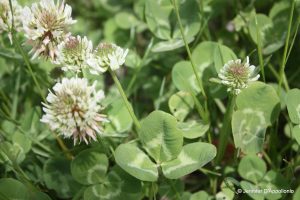Selecting Forage Species
(Lesson 2. Plant Species Selection continued)

Generally forages in Maine are divided into three groups: cool-season grasses, legumes, and alternative forages. The mix of these will depend on soil type, drainage, pH, fertility, and personal preference. All are capable of successfully producing feed for the grazing animal. Ideally, the production cycle of the forages will match the stage of production of the grazing animals. In other words, maximum forage production and quality should coincide with the herd’s maximum nutritional requirements, such as during the calving and breeding season.
Appendix A describes the characteristics of different forages, and can be used as a reference for deciding which forages to include in a pasture program. When quality is of concern, legumes provide the highest quality forage followed by cool season perennial grasses, and cool season annual grasses.
Cool Season Grasses
Most of the perennial grasses growing in Maine are cool season grasses. Cool season grasses produce the majority of their production in the spring, followed by a slump period during the hot summer months and a second growth spurt in the fall. The most common cool season grasses are smooth bromegrass, timothy, orchard grass, and bluegrass. Although quackgrass is considered a weed in row crops, lawns, and gardens, some graziers are including it in their pasture mixtures because of its durability and persistence. Kentucky bluegrass is generally a low yielding species unless heavily fertilized. Bluegrass has a tendency to become more prominent in pastures that are over-grazed. However, well managed bluegrass can be productive. Another grass worthy of trial is perennial ryegrass. Ryegrasses have generally not been recommended in the past because they lack winter hardiness. With the introduction of more winter hardy varieties, perennial ryegrasses should be tried in southern and coastal counties of Maine to see if they have a place in your system. Ryegrasses can be highly competitive with forage legumes under frequent cuttings or grazings.
Another characteristic of grasses that a producer can take advantage of is the range of maturity of different species, i.e. orchardgrass is much earlier maturing than timothy. The rationale is similar to planting corn hybrids or soybean varieties with different maturities, they are not all ready to graze at the same time.
Advantages grasses have over legumes include the ability to grow well under less fertile soils and to tolerate mismanagement better. Grasses also tolerate livestock trampling better than legumes. A major disadvantage of cool season grasses is the need for nitrogen fertilization if you wish to achieve high yields. Another disadvantage of cool season grasses is the “summer slump,” a period of slow growth during the hot summer months.
Warm Season Perennial Grasses
Warm season perennial grasses usually out perform cool season grasses in summer months and have a high value for wildlife. For these reasons, they have received much attention in areas south of Maine. Warm season perennial grasses only occur naturally on sandy soils in southern Maine and in isolated patches along the coast and along the major river systems. Warm season grass seed is very expensive and stands are difficult and slow to establish. Cool season grasses will easily out compete warm season grasses given the soils and rainfall in Maine. Because of this competition, warm season grass plantings usually result in failure except on sandy soils. Successful plantings require good weed control of the cool season grasses. There have been very few successful plantings in Maine. Consideration of warm season perennial grasses for grazing or forage in Maine will probably be limited to managing them where they do occur.
Annual Warm Season Grasses
Annual warm season grasses, such as sorghum/sudangrass and pearl millet, can be used to complement cool season pastures, and can also provide a site for manure utilization. Annual warm season grasses can work well as an emergency pasture or hay crop and to provide feed during the “summer slump.” These grasses have the ability to produce high quality forage during summer and early fall. However, the high cost associated with annual establishment and high fertility requirements usually result in higher costs of gain compared to perennial cool season forages. The high cost of annual establishment along with the potential for nitrate poisoning and prussic acid or cyanide poisoning have limited the use of annual warm season grasses in Maine. These should be considered on a trial basis to see if they have a place in your system.
Adding Legumes to the Mix
Adding legumes to forage mixtures will often increase forage quality. Legumes, like cool season grasses, have the majority of growth in the spring, but the summer slump is not as drastic. Alfalfa is the most widely used legume in perennial hay stands and where good soil conditions, such as proper drainage and a pH of 6.6 to 7.0, are present. Alfalfa does not tolerate grazing as well as clover. Clovers are generally easy to establish, and can tolerate wetter soils and soils with a lower pH than alfalfa. However, some clovers usually have a short stand life. Birdsfoot trefoil is difficult to establish due to its inability to compete with companion crops, grasses, and weeds. However, with careful management trefoil is an ideal pasture species due to its quality and absence of bloat potential.
The major advantages which legumes have over grasses include the ability to fix nitrogen from the air, higher protein content, higher intake potential, drought tolerance, and a slower decline in maturity. However, legumes usually require higher soil pH, have a lower tolerance to wet soils, and are less persistent than most adapted grasses. Bloat is a concern with some legumes, but bloat incidence can be reduced by including grasses in the mix and proper grazing management. Lesson 6 of this home study course offers some recommendations for managing animals that are grazing legume pastures.
